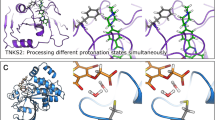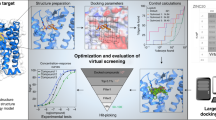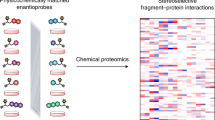Abstract
In a cell, there are many possibilities for cross interactions between enzymes and small molecules, arising from the similarities in the structures of the metabolites and the flexibility in binding of protein active sites. Despite this promiscuity, the cognate partners must be able to recognize each other in vivo, for the cell to function efficiently. This study examines the basis of this selectivity in recognition using standard docking calculations and finds significant improvement when proteins and ligands are cross-docked. We find that cognate molecules rarely form the most stable complexes and that specificity may be driven either by recognition of the substrate by the enzyme or the recognition of the enzyme by the substrate. Despite limitations of the in silico methods, especially the scoring functions, these calculations highlight the need to consider cross reactions in the cell and suggest that localization and compartmentalization must be important factors in the evolution of complex cells. However, the inherent promiscuity of these interactions can also benefit an organism, by facilitating the evolution of new functions from old ones. The results also suggest that high-throughput screening should involve not just a panel of small molecules, but also a panel of proteins to test for cross-reactivity.
This is a preview of subscription content, access via your institution
Access options
Subscribe to this journal
Receive 12 print issues and online access
$209.00 per year
only $17.42 per issue
Buy this article
- Purchase on Springer Link
- Instant access to full article PDF
Prices may be subject to local taxes which are calculated during checkout






Similar content being viewed by others
References
Schwab, W. Metabolome diversity: too few genes, too many metabolites? Phytochemistry 62, 837–849 (2003).
Romesberg, F.E., Spiller, B., Schultz, P.G. & Stevens, R.C. Immunological origins of binding and catalysis in a Diels-Alderase antibody. Science 279, 1929–1933 (1998).
Vazquez-Laslop, N., Zheleznova, E.E., Markham, P.N., Brennan, R.G. & Neyfakh, A.A. Recognition of multiple drugs by a single protein: a trivial solution of an old paradox. Biochem. Soc. Trans. 28, 517–520 (2000).
O'Brien, P.J. & Herschlag, D. Catalytic promiscuity and the evolution of new enzymatic activities. Chem. Biol. 6, R91–R105 (1999).
James, L.C. & Tawfik, D.S. Catalytic and binding poly-reactivities shared by two unrelated proteins: the potential role of promiscuity in enzyme evolution. Protein Sci. 10, 2600–2607 (2001).
Jeffery, C.J. Moonlighting proteins. Trends Biochem. Sci. 24, 8–11 (1999).
Copley, S.D. Enzymes with extra talents: moonlighting functions and catalytic promiscuity. Curr. Opin. Chem. Biol. 7, 265–272 (2003).
Pocker, Y. & Sarkanen, S. Oxonase and esterase activities of erythrocyte carbonic anhydrase. Biochemistry 17, 1110–1118 (1978).
Jackson, R.C. & Handschumacher, R.E. Escherichia coli L-asparaginase. Catalytic activity and subunit nature. Biochemistry 9, 3585–3590 (1970).
O'Brien, P.J. & Herschlag, D. Sulfatase activity of E. coli alkaline phosphatase demonstrates a functional link to arylsulfatases, an evolutionarily related enzyme family. J. Am. Chem. Soc. 120, 12369–12370 (1998).
Van de Velde, F., Könemann, L., van Rantwijk, F. & Sheldon, R.A. Enantioselective sulfoxidation mediated by vanadium-incorporated phytase: a hydrolase acting as a peroxidase. Chem. Commun. 17, 1891–1892 (1998).
Hefner, T., Arend, J., Warzecha, H., Siems, K. & Stockigt, J. Arbutin synthase, a novel member of the NRD1β glycosyltransferase family, is a unique multifunctional enzyme converting various natural products and xenobiotics. Bioorg. Med. Chem. 10, 1731–1741 (2002).
Van Regenmortel, M.H.V. Molecular recognition in the post-reductionist era. J. Mol. Recognit. 12, 1–2 (1999).
Nobeli, I., Ponstingl, H., Krissinel, E.B. & Thornton, J.M. A structure-based anatomy of the E.coli metabolome, J. Mol. Biol. 334, 697–719 (2003).
Jensen, R.A. Enzyme recruitment in evolution of new function. Annu. Rev. Microbiol. 30, 409–425 (1976).
Ma, B., Shatsky, M., Wolfson, H.J. & Nussinov, R. Multiple diverse ligands binding at a single protein site: a matter of pre-existing populations. Protein Sci. 11, 184–197 (2002).
Koehler, R.T. & Villar, H.O. Statistical relationships among docking scores for different protein binding sites. J. Computer-Aided Mol. Des. 14, 23–37 (2000).
Chen, Y.Z. & Zhi, D.G. Ligand-protein inverse docking and its potential use in the computer search of protein targets of a small molecule. Proteins Struct. Func. Genet. 43, 217–226 (2001).
Chen, Y.Z. & Ung, C.Y. Prediction of potential toxicity and side effect protein targets of a small molecule by a ligand–protein inverse docking approach. J. Mol. Graph. Model. 20, 199–218 (2001).
Rockey, W.M. & Elcock, A.H. Progress toward virtual screening for drug side effects. Proteins Struct. Func. Genet. 48, 664–671 (2002).
Hetényi, C., Maran, U. & Karelson, M. A comprehensive docking study on the selectivity of binding of aromatic compounds to proteins. J. Chem. Inf. Comput. Sci. 43, 1576–1583 (2003).
Karp, P.D. et al. The Ecocyc database. Nucleic Acids Res. 30, 56–58 (2002).
Fleischmann, A. et al. IntEnz, the integrated relational enzyme database. Nucleic Acids Res. 32, D434–D437 (2004).
Morris, G.M. et al. Automated docking using a Lamarckian genetic algorithm and an empirical binding free energy function. J. Comput. Chem. 19, 1639–1662 (1998).
McConkey, B.J., Sobolev, V. & Edelman, M. The performance of current methods in ligand-protein docking, Curr. Sci. India 83, 845–856 (2002).
Taylor, R.D., Jewsbury, P.J. & Essex, J.W. A review of protein–small molecule docking methods. J. Comput. Aid. Mol. Des. 16, 151–166 (2002).
Halperin, I., Ma, B., Wolfson, H. & Nussinov, R. Principles of docking: an overview of search algorithms and a guide to scoring functions. Proteins Struct. Func. Genet. 47, 409–443 (2002).
Nicholson, J.K. & Wilson, I.D. Understanding 'global' systems biology: metabonomics and the continuum of metabolism. Nat. Rev. Drug Discov. 2, 668–676 (2003).
Laskowski, R.A., Luscombe, N.M., Swindells, M.B. & Thornton, J.M. Protein clefts in molecular recognition and function. Protein Sci. 5, 2438–2452 (1996).
Srere, P.A. The metabolon. Trends Biochem. Sci. 10, 109–110 (1985).
Godden, J.W., Stahura, F.L. & Bajorath, J. Statistical analysis of computational docking of large compound databases to distinct protein binding sites. J. Comput. Chem. 20, 1634–1643 (1999).
Berman, H.M. et al. The Protein Data Bank. Nucleic Acids Res. 28, 235–242 (2000).
Boutselakis, H. et al. E-MSD: the European Bioinformatics Institute macromolecular structure database. Nucleic Acids Res. 31, 458–462 (2003).
Gasteiger, J., Rudolph, C. & Sadowski, J. Automatic generation of 3D-atomic coordinates for organic molecules. Tetrahedron Comp. Method. 3, 537–547 (1990).
Laskowski, R.A. et al. PDBsum: a web-based database of summaries and analyses of all PDB structures. Trends Biochem. Sci. 22, 488–490 (1997).
Laskowski, R.A. SURFNET: A program for visualising molecular surfaces, cavities and intermolecular interactions. J. Mol. Graph. 13, 323–330 (1995).
Acknowledgements
We wish to thank Tim Massingham for advice on the statistics in this study, Jonathan Barker for help with creating Figure 6, and John Mitchell, Robert Glen and Hannes Ponstingl for useful discussions. A.M. visited the European Bioinformatics Institute with a Marie Curie Training Site Fellowship of the European Commission Program 'Quality of Life,' contract number: QLRI-1999-50595. I.N. acknowledges financial support from the Medical Research Council, in the form of a Special Training Fellowship in Bioinformatics.
Author information
Authors and Affiliations
Corresponding author
Ethics declarations
Competing interests
The authors declare no competing financial interests.
Supplementary information
Supplementary Fig. 1
Docked solutions with rmsd greater than 3 Å (PDF 309 kb)
Supplementary Table 1
The data set of 29 complexes with known protein crystal structures (PDF 46 kb)
Supplementary Table 2
List of enzymes and metabolites used in this study (PDF 9 kb)
Rights and permissions
About this article
Cite this article
Macchiarulo, A., Nobeli, I. & Thornton, J. Ligand selectivity and competition between enzymes in silico. Nat Biotechnol 22, 1039–1045 (2004). https://doi.org/10.1038/nbt999
Published:
Issue Date:
DOI: https://doi.org/10.1038/nbt999
This article is cited by
-
Docking-based inverse virtual screening: methods, applications, and challenges
Biophysics Reports (2018)
-
Chemical genetics strategies for identification of molecular targets
Phytochemistry Reviews (2013)
-
Dehydrogenase Enzymes Associated to Glycolysis in Beef Carcasses Stored at 0 °C
Food and Bioprocess Technology (2013)
-
Computational screening of novel thiamine-catalyzed decarboxylation reactions of 2-keto acids
Bioprocess and Biosystems Engineering (2011)
-
Modelling substrate specificity and enantioselectivity for lipases and esterases by substrate-imprinted docking
BMC Structural Biology (2009)



